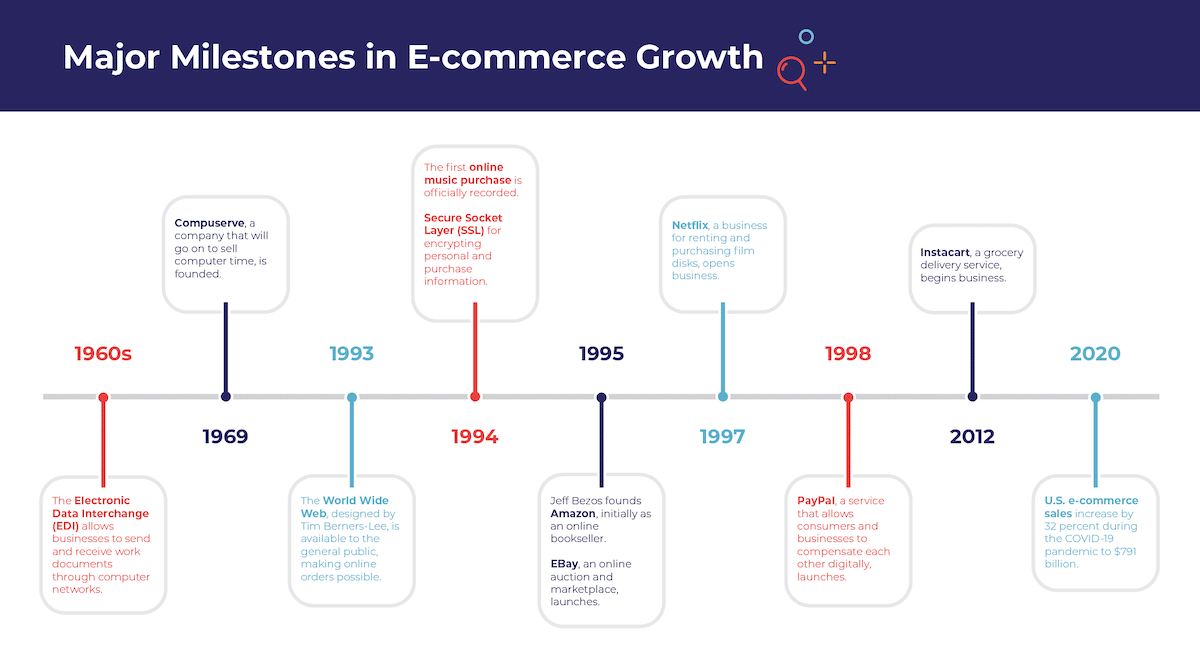E-Commerce

E-commerce, or electronic commerce, is online-conducted business, including marketing, sales, and fulfillment. Consumers and businesses place and track orders at least partially through the Internet. Customers view products or services, purchase and pay for their selections, have them shipped, and receive after-the-sale customer support through on the seller’s website. Retailers who use e-commerce may operate physical stores (e.g. Target, Publix, Lowe’s) or exist entirely online (e.g. Amazon, Rakuten, Alibaba).
In the earlier stages of the Internet, e-commerce was not available to everyone. The growth of the Internet over the past fifty years has made online selling more accessible to the public. Now, e-commerce is feasible for anyone who can set up a website and monetize their products or services.
In this definition...
History of e-commerce
E-commerce has roots in the 1960s, when businesses would send business documents electronically through designated computer networks. Compuserve, a network for news, file sharing, and discussion, sold computer time to customers. The service first launched in 1969 and eventually became one of the first open electronic commerce operations.
In the mid-1990s, the World Wide Web and subsequent websites solidified e-commerce. Tim Berners-Lee made the web available to the public in 1993. As retailers adopted online sales, they needed security methods to prevent customer data theft. In 1994, Netscape invented Secure Socket Layer (SSL), the first protocol for protecting personal purchase information on the Internet.
What followed was a decade of explosive growth for both the internet and e-commerce. Online shopping, payment, and fulfilment lead to the birth of several completely new retail models that have entirely transformed the way people buy and sell.
In 1994, Jeff Bezos founded Amazon as an online book retailer, and it launched the next year. Amazon.com became wildly successful, making books available to consumers at lower prices and with greater options than they might find in brick-and-mortar bookstores. Amazon extended its sales to media (movies, games, music) in 1998 and home goods in 1999.
1995 also marked eBay‘s launch. eBay made e-commerce available to consumers who wanted to bypass stores and simply purchase from other individuals. eBay began as an auction site, allowing customers to bypass set pricing and giving them more say in how much they paid for items.
eBay also expanded the range of items that could be purchased online: used goods are much more common on eBay than on other commerce platforms. eBay helped start the customer to customer (C2C) commerce model.
Netflix, another e-commerce giant, made its movie rental services available in 1997. Customers could order DVDs online, have them shipped, and return them once they had watched. Netflix’s rental options broadened customers’ viewing choices and eventually became web-based.
In 1998, PayPal launched, allowing individuals to exchange money for services electronically. PayPal provided a way to pay others back without currency, making it easy to quickly send money to people or businesses online.
Features of e-commerce
Generally speaking, e-commerce:
- Offers greater availability of items, from a broader geographical scope, than can be found in physical stores in one local region
- Allows customers to order from computers, tablets, and mobile phones
- Is monitored and regulated by the Federal Trade Commission (FTC) in the advertising and marketing space, ensuring that e-commerce practices meet consumer data privacy expectations
Current demands from buyers and sellers include:
- Reliable and fast mobile platforms so that customers find it easy to place orders on phones and tablets. This includes having well-made applications with understandable and simple interfaces.
- Excellent marketing campaigns and AI-driven emails and product positioning.
- Privacy, payment, and shipment processes that are compliant with security regulations, such as PCI-DSS (credit card data protection).
- Sustainability, which includes recyclable shipping containers and practicing ethical warehouse behavior and product creation, priorities that are increasing for younger customers as they shop with companies.
The effect of COVID-19 on e-commerce
The COVID-19 pandemic dramatically increased the need for online purchases. When local and national quarantine restrictions were imposed in March 2020, customers were forced to curtail their in-person shopping. Retailers of all sizes scrambled to adopt BOPIS (buy online, pick up in store) practices, preparing orders in advance for customers to limit their time in the store. Others delivered groceries or restaurant meals to customers’ homes.
Widespread quarantining caused many people to develop a scarcity mindset and purchase extra hand sanitizer, soap, toilet paper, and other basic sanitary necessities. Panic buying affected in-store stock and online demand, as supply could not meet the current demand. Stores began to impose limits on the number of items, particularly toilet paper and hand sanitizer, that customers could purchase.
Many businesses shut down their physical locations; those that were able transitioned to an online-sales push. Small businesses that previously didn’t rely on Internet sales often pivoted to selling gift cards and other items online; some weren’t able to make the sales required to profit and consequently shut down.
E-commerce in the United States increased by 32 percent in 2020, rising from to nearly $792 billion. Some commerce experts didn’t expect that number until 2022 prior to the pandemic.
Types of e-commerce models
B2B
Business to business (B2B) commerce models encompass all companies that sell services to each other for mutual benefit. This includes companies like Amazon, which provides cloud computing services (AWS) to other businesses like Netflix, and Salesforce, a powerful CRM solution that many companies use as a customer management platform along with their own software.
B2B e-commerce and marketing is a more expansive arena than B2C because The B2B commerce model involves more moving parts and people.
For example, a company that creates business software must engage developers, designers, and managers to oversee the software creation process; they must also hire marketers and customer relationship managers to sell the product to other companies. Finally, they’ll need to engage in technical support for purchasers of that software.
In contrast, a single consumer buying a single product on Amazon may only interact with the marketing, purchase and customer support aspects of e-commerce.
B2C
Business to consumer (B2C) e-commerce is the most well-known form of e-commerce. Retail sellers (e.g., Amazon, Walmart, Chick-Fil-A, CVS) list available goods and services on the Internet. Individuals purchase goods/services online, using a card or bank account. B2C e-commerce fulfills orders by both shipping goods and providing BOPIS to consumers.
C2B
Consumer-to-business (C2B) e-commerce includes any type of sale from an individual to a business. Contract and freelance work are the best examples of C2B commerce. People searching for a job can contact a business, requesting work, or can sell goods to a company.
Freelance and contract work can be either C2B or C2C, depending on who is purchasing the services offered. One popular freelance platform, Upwork, allows individuals and businesses to list project opportunities, then freelancers apply and market themselves to receive that work. Contract and freelance roles often come through C2B commerce, including on the Internet.
Read more: What Is a Gig Worker?
C2C
Consumer-to-consumer e-commerce involves sales by individuals to individuals. In this e-commerce model, people sell to each other rather than businesses through channels like Facebook Marketplace or eBay. This method can also include sale of services—for example, a woman who cuts grass, does landscaping, and markets her personal business to other people through social media or email.
C2C commerce is the model that most resembles historical commerce—trading goods and services based on an agreement between two individuals, often with the option to barter. C2C commerce is the most flexible model in terms of negotiating trade terms and making non-currency exchanges.
Top e-commerce platforms
Any business that sells goods or services online is an e-commerce platform. We’ve highlighted five of the most recognizable and popular, each of which serves a slightly different purpose. These top platforms show the variety of e-commerce channels available in the current marketplace.
Amazon
Amazon has expanded not only to selling almost every kind of good but also to cutting-edge technology services. Amazon changed the way e-commerce was viewed by providing lower prices than brick and mortar stores. Since its launch in the mid-nineties, Amazon has added extremely fast shipping, raising customer expectations of how quickly they can receive orders.
Amazon is also a tech giant; its Web Services platform includes relational database management systems, data storage, and smart home technology such as TVs and speakers.
eBay
eBay, which began as the Auction Web, is now available in 180 countries. As one of the world’s most recognizable forms of C2C commerce, eBay allows both sellers of used goods and buyers searching for often obscure items to benefit from online trade. eBay helped create the market for people to find goods they wouldn’t be able to locate in a store and for sellers to make a profit from otherwise useless items.
Walmart Marketplace
Walmart Marketplace allows official Walmart partners and other B2C businesses to market their products alongside Walmart’s on the retail giant’s website. The products are only available online, not in Walmart stores.
Etsy
Etsy, founded in 2005, is an online store for creators to market and sell their handmade goods and crafts directly to consumers. Businesses that sell through Etsy must comply with Etsy’s branding guidelines.
Rakuten
Japanese e-commerce company Rakuten differs from the other companies on this list because it gives customers cash back for items purchased through its site. Rakuten, formerly Buy.com, was initially designed as an online mall. Retailers pay to sell their products on Rakuten’s website, allowing the company to pay the cash-back incentive to its customers.
Top e-commerce vendors
The complexities of e-commerce require powerful computing platforms that incorporate marketing, customer relationship management, email automation, shipping, logistics, customer support, and transaction solutions in a unified—typically cloud-based—platform. Over the last 15 years, several top vendors have emerged.
Shopify
Shopify is a web design platform that gives an arsenal of e-commerce features to businesses that sell many products and plan to scale. Shopify’s numerous pre-configured website design themes and templates simplify the creation and launch of an e-commerce site for retailers.
Shopify offers other important e-commerce features, such as SSL certificates, help with search engine optimization, a blog option, and product management and marketing solutions.
WooCommerce
WooCommerce provides e-commerce to companies that want to sell products or services from their WordPress-based website, offering template and theme choices for its users. WooCommerce doesn’t require licensing fees. It includes add-ons for PayPal integrations and other payment options.
Salesforce Commerce Cloud
Salesforce Commerce Cloud’s Software-as-a-Service e-commerce platform manages the back end of e-commerce for businesses. Salesforce is one of the most popular customer management solutions available, and its e-commerce platform has similar sales and marketing power.
NetSuite SuiteCommerce
NetSuite, owned by Oracle, offers an e-commerce platform for retailers that require flexible payment and shipping choices, and have content marketing needs. These include themes and extensions for the retailer’s online store, PayPal integration, and options for authentication and authorization. Sellers can set up different shipping options, configure the platform’s search feature, and add a store locator. SuiteCommerce also provides marketing and merchandising, content management options, and a blog extension.
Pros and cons of e-commerce
E-commerce has accelerated the amount of shopping customers can do from home and provided more buying options. It’s also allowed small businesses that can’t afford large brick and mortar locations to still profit from online sales. Advantages of e-commerce include:
- Availability of a variety of items from a variety of geographical locations. Customers have more selections from which to choose.
- Convenience of shopping from home and buying without going anywhere.
- More customer data for companies to track and use.
E-commerce has some drawbacks or disadvantages for both buyers and sellers.
- Brick and mortar shopping is still very popular, despite the development of augmented reality for replicating in-person shopping. Many customers still prefer shopping in the store.
- Servers, networks, and websites can go down, prohibiting customers from purchasing goods.
- Shipping, tracking, and returns take extensive logistical management.
- Online sales carry the risk of electronic fraud. Hackers can find ways to steal customer payment information, and unsavory individuals can set up e-commerce sites, too.
AI in e-commerce
Artificial intelligence benefits e-commerce by streamlining online sales processes. AI enables intelligent customer data management, algorithms that optimize site searches, and AI-assisted email marketing campaigns. Chatbots, which learn from each conversation, have initial conversations with potential customers and can funnel them to the best next step in their buying process.
Read More: How to Add Ecommerce to Your Website
Related Links
WHAT IS ECOMMERCE? EVERYTHING YOU NEED TO KNOW
Understanding the COVID-19 Effect on Online Shopping Behavior

